| Why the concern about FHB? | Where is this disease a problem? | How to minimize the FHB risk? | Testing grain | Grading tolerances for fusarium-damaged wheat and barley | Testing for DON and Fusarium species
Fusarium head blight (FHB), also known as scab or tombstone, is a disease of wheat, barley, oats and other small cereal grains and corn (Figure 1). It is caused by several species of Fusarium; however, Fusarium graminearum is the primary species involved. In 1999, Fusarium graminearum was declared a pest under the Alberta Agricultural Pests Act.
Fusarium graminearum is a serious cereal disease that has been spreading across Alberta. For tips on how to manage the disease, view the video below – “Stop Fusarium Before it Stops You.” For a more detailed (30 minute) presentation, see “Fusarium Management.”
(Stop Fusarium Before it Stops You. Duration: 4:25 minutes)
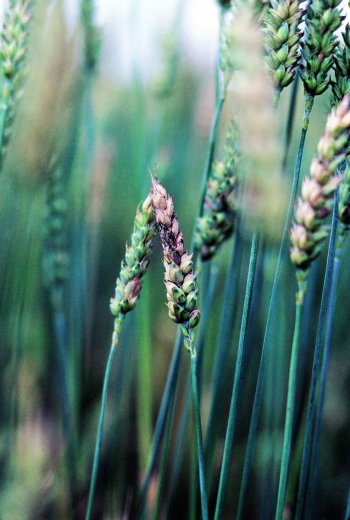
Figure 1. Fusarium graminearum infection in wheat: note the bleached heads.
This disease reduces yield and grade and may also contaminate the grain with fungal toxins (mycotoxins). FHB is favoured by humid conditions during flowering and early stages of kernel development.
FHB is recognized in the field by the premature bleaching of infected spikelets and the production of orange, spore-bearing structures called sporodochia at the base of the glumes. During wet weather, there may be whitish, occasionally pinkish, fluffy fungal growth on infected heads in the field.
Diseased spikelets can contain visibly affected kernels. The grading term given to visibly affected wheat seeds is fusarium damaged kernels (FDK), whereas in barley, it is called fusarium mould (Figure 2).
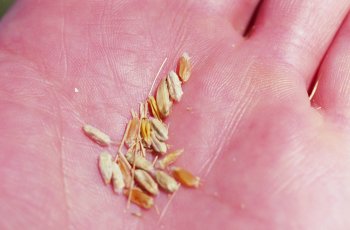
Figure 2. The white, shriveled kernels are called FDK (fusarium damaged kernels) or tombstones. Fusarium head blight is also known as tombstone blight.
FDK in wheat are shrunken and typically chalky white, while fusarium mould on barley is an orange or black encrustation of the seed surface. Much of the severely infected wheat is poorly filled and may be blown out the back of the combine due to its low kernel weight. Grain infected after the flowering stage may be heavy enough to be harvested along with healthy grain, although most FDK will result from infections that occur during flowering.
The fungus may eventually kill the developing seed at about the soft dough stage. Symptoms of fusarium mould in barley or oats are usually sparse, making it difficult to tell if grain has been infected.
Why the concern about FHB?
Wheat and barley infected by FHB may contain mycotoxins such as deoxynivalenol (DON), also known as vomitoxin. As mycotoxins go, DON is one of the least toxic to animals but may result in reduced feed consumption or feed refusal. This toxin is produced primarily by F. graminearum and F. culmorum. Non-ruminants are the most sensitive to the presence of DON (Figure 3).
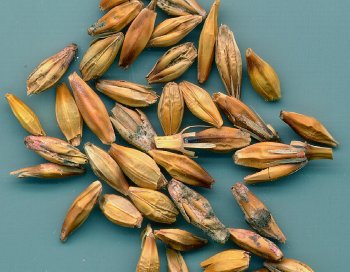
Figure 3. Symptoms of Fusarium graminearum infection in barley are not as distinctive as with wheat and can be confused with other diseases that cause darkened kernels. In this heavily F. graminearum infected sample, the DON levels reached 15 ppm.
In eastern Saskatchewan, Manitoba, eastern Canada and in the United States, Fusarium graminearum is normally responsible for FHB. FDK are occasionally found in soft white spring wheat grown under irrigation in southern Alberta, but DON levels are usually very low. In wheat from southern Alberta, the fungus most often associated with DON production has been Fusarium culmorum, although Fusarium graminearum can also be present, even dominant, in some samples. In the dryland farming areas of Alberta, Fusarium graminearum has recently been found at trace levels in more than a few fields. In eastern Saskatchewan in 1993, this pathogen was also found at trace levels, but after several years of steadily increasing incidence and severity, it has become a major cereal pathogen in that area. The levels of this pathogen are increasing in western Saskatchewan.
Fusarium graminearum is not likely to spread rapidly (i.e. within one growing season and causing severe infections) across the prairies. However, it does appear to be slowly spreading westward. Sometimes, tan spot or septoria blight infections have been confused with FDK in wheat in both Alberta and Saskatchewan. The only way to distinguish kernels infected with these pathogens from those infected by Fusarium species is to have the seed cultured in petri dishes on a suitable growth medium.
Fusarium fungi can produce DON levels as high as 30 parts per million (ppm) in wheat and barley. On average, 1 per cent FDK (if caused by F. graminearum or F. culmorum) will produce 1 ppm DON, although it can range from 0.5 to 4 ppm. Thus, 5 per cent FDK in wheat will give, on average, 5 ppm DON.
Some studies have shown that beef cattle can feed on grain that has up to 12 ppm DON, but calves may have problems at much lower contamination levels. Non-ruminants like hogs will tolerate 1 ppm, but pregnant animals or breeding stock may suffer even at this level. Dairy cows have been shown to tolerate 8 ppm DON without affecting milk yield. Calves, lambs and lactating ewes have no effects at 10 ppm or more. Adult cows, adult sheep and poultry can tolerate up to 15 ppm DON in feed grain. Agriculture and Agri-Food Canada guidelines are 1 ppm for swine, dairy cattle and horses and 5 ppm for growing beef cattle, sheep and poultry. The toxicity of DON is such that animals or humans do not die from ingesting it.
The Federal Health Protection Branch allows 2 ppm of DON in uncleaned soft white winter wheat and 1 ppm in uncleaned soft white spring wheat intended for infant foods. A suspicion of fusarium mould in malting barley can lead to rejection. Several malting companies have a zero tolerance for DON in barley.
Where is this disease a problem?
Outbreaks of FHB in wheat or barley and other grains generally occur in the more humid regions of North America. Over the last several years, FHB has been the most important cereal disease of the eastern Canadian prairies, eastern Canada, and the midwest US.
Using corn in rotation with small cereal grains has been shown to increase the problem, although corn is not an essential link in the disease cycle. All cereal and corn residue can help the fungus overwinter and will act as an inoculum source in the spring. Corn stubble can harbor huge amounts of Fusarium fungi that may infect small grain heads, causing fusarium head blight in barley and wheat.
Where FHB levels are high, mycotoxin problems are not unusual. Although FHB and FDK can occur in the western prairies, levels are usually very low and the causal species is usually not Fusarium graminearum. Grain from the western prairies can become mouldy from long-term weather exposure in the swath or by heating up after harvest, but this damaged grain will usually not contain DON since the causal species is rarely a DON producer. However, the grain may contain other compounds that could affect its suitability as feed.
How to minimize the FHB risk?
After an extensive public consultation process, the Province of Alberta developed the Alberta Fusarium graminearum Management Plan. This plan came into effect October 1, 2002, and specifies the provincial strategy for meeting the threat of this devastating disease, while still sustaining all sectors of the agriculture industry in Alberta.
The control strategies in this plan are enforced under the authority of the Alberta Agricultural Pests Act. The long-term goal of the management plan is to prevent the introduction and establishment of F. graminearum in Alberta until effective disease control measures for this pathogen are developed. It is expected that the most effective control of this disease will involve the development of resistant wheat and barley cultivars.
The prevention and control strategies presented in the management plan address the most likely avenues of introducing F. graminearum into Alberta fields according to the level of associated risk. There is a zero tolerance for F. graminearum in seed grain, including corn, because one of the surest ways to introduce and establish this pathogen in a field is to plant diseased seed.
Local seed
The requirement for all Alberta seed, including common seed, to be tested and certified free of F. graminearum is an important part of the entire disease control strategy. It is true that since Alberta is essentially free of F. graminearum, seed produced in Alberta represents a relatively low risk. However, it is also true that it is important to be vigilant to prevent the introduction of F. graminearum into Alberta fields.
The seed testing requirement will allow low level infestations to be monitored for and caught early, before the outbreaks get out of control. Focusing entirely on seed produced outside the province ignores the real possibility of low level infections becoming established and spreading within the province. Testing Alberta-produced cereal seed represents an important early warning component of F. graminearum control.
Imported seed
All imported cereal seed also has to be treated with a fungicide seed treatment that is registered for control of seed-borne Fusarium. This step adds another level of protection against the possibility of low level infections in seed lots that test negative for the pathogen. It is highly recommended, but not required, that all seed produced in Alberta also be treated with a fungicide.
Feed grain
Feed grain represents a risk for introducing F. graminearum due to the sheer volume of feed grain that is brought into Alberta. The management plan recognizes this risk and requires that feed grain be handled responsibly in accordance with a number of best management practices. The key components of the best management practices are to ensure that all infected grain is fed to cattle and that spillage is avoided, with spilled grain cleaned up and composted.
It is known that F. graminearum on infected grain is killed during passage through the digestive system of cattle. Composting infected grain or crop residue (grass hay or straw) to reach a temperature of 60 to 70oC for two weeks will also kill any F. graminearum present in the grain or crop residue.
Infected grain must not be allowed to come in contact with the soil, which would allow F. graminearum to establish a foothold in roadsides or fields. Unloading sites must be covered or equipped with drop socks and wind fences to ensure that grain does not blow onto adjacent soil. Trucks, or any vehicles, used to haul feed grain must be securely tarped. Trucks must be cleaned thoroughly at the unloading site and all remaining grain composted. Feed grain cannot be stored in direct contact with the soil, nor can it be uncovered. Moisture contacting this grain can promote the growth and development of F. graminearum.
All things considered, it is recommended that producers buy Fusarium-free grain as this precaution greatly reduces the risk of introducing the pathogen. Recent experience has shown that Fusarium-free feed grain has been available to those who have insisted on grain that has been tested and found free of F. graminearum.
Hay and straw
Grass hay and straw from areas infested with F. graminearum can also carry the pathogen and should be handled in accordance with the best management practices for feed grain. Of the two products, grass hay represents a lower risk as the hay should all go through the cattle, which will kill any F. graminearum present.
Bedding straw represents a very high risk of spreading F. graminearum because imported straw will very likely have high levels of infection, and the practice of spreading bedding straw in fields can bring the pathogen in direct contact with the soil. If the bedding straw is not collected and composted in early spring, any F. graminearum present is in an excellent position to establish in the field.
In the field
The last line of defense occurs when F. graminearum infections are identified in cereal fields (Figure 4). Such an occurrence would trigger an eradication strategy where the crop is immediately ensiled or harvested, and the residue carefully managed and cultivated. The field would be taken out of cereal production for three years to allow the crop residue to degrade, resulting in the eradication of the pathogen. Fusarium graminearum does not survive in fields where the host material has degraded and is no longer present.
Experience has shown that it is possible to eradicate this pathogen from a field where it has begun to establish. Swift action is required, and the strategy will only be effective if merely a few fields become infected. Attempts to eradicate F. graminearum from a large number of infected fields over a wide area will not likely be successful.
The success of the Alberta Fusarium graminearum Management Plan depends on the effective participation of all players in Alberta's agriculture industry. Any inconvenience or temporary hardship in complying with the control measures is a small price to pay when compared to the long-term loss that would be associated with an established F. graminearum problem.
Growing season
During the growing season, growers should check fields for the presence of this disease. Check for symptoms on cereal heads about three weeks after anthesis and in the grain at harvest. If F. graminearum is found, a rotation out of cereals should be considered, as should the planting of varieties least susceptible to the disease.
Unfortunately, varieties resistant to head blight are not available, but varieties and crop species do vary in their level of susceptibility. In general, the level of susceptibility decreases from durum wheat to CPS wheat to hard red spring wheat to barley and to oats.
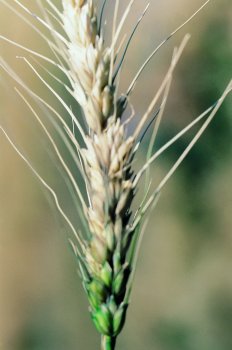
Figure 4. Partial Fusarium graminearum infection of the head, the flowers in the bleached portion of the head are killed.
Currently, there is substantial activity involving the development of resistant cereal varieties both in Canada and the U.S. If producers are in areas where F. graminearum is present or they are concerned about FHB, they are encouraged to consult provincial crop variety guides for help in choosing varieties that are the least susceptible to this disease.
The Canadian Grain Commission (CGC) offers a grading service to producers who submit samples for grade, dockage and/or moisture analysis. This service requires a 1000 g (about 2 lbs.) representative sample and should be sent to their nearest CGC Service Centre. There is a fee for this service.
Testing grain
Several companies in western Canada, including the Canadian Grain Commission, offer DON testing services. Most of these sources will use a 'quick' test. The simplest tests are a 'yes/no' type, where the sample is judged to have more or less toxin than a chosen standard. A more sophisticated test will place the level between two chosen standards, without giving an exact number. The most precise, and somewhat more expensive quick test, will produce a number (in parts per million) for the toxin level in the sample (Figure 5).
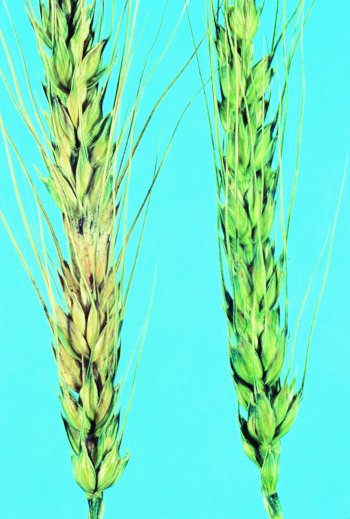
Figure 5. Fusarium graminearum infection in barley.
All tests will have a detection limit, below which the sample is said to have a non-detectable level of the toxin. In many of the most popular tests, this detection limit is 0.5 ppm. A more accurate but far more expensive type of test is one that uses sophisticated instrumentation. The detection limit of this type of test is about 0.05 ppm. As with any test, sampling is critical. Without a good, representative sample, test results will not accurately reflect the bulk from which the samples were taken.
Before choosing a testing lab, growers should decide what type of test result they require. The less exact the result required, the cheaper the test (usually). The quick tests can range from around $25.00 to $50.00. Ask if there is a discount for submitting several samples at once (if appropriate). Growers should ask if the company uses check samples to validate the tests, and if so, how often.
Cost should not be the sole reason for choosing one company over another. If the test result does not make sense to you (if, for example, you receive a high DON result but the wheat had little or no FDK), consider retesting the sample for DON and also perhaps having it tested for the presence or absence of DON-producing pathogens like Fusarium graminearum or Fusarium culmorum. In addition, you may want to consider seeking the advice of individuals familiar with mycotoxin testing in cereal grain.
In Alberta, DON has mainly been found in soft white spring wheat at relatively low levels. However, when handling FDK in grain, the dust may contain high levels of the fungus. Grain handlers should take all the same precautions they would if they were handling mouldy grain. These precautions could include using masks, goggles and protective clothing.
For more information, contact the Alberta Ag-Info Centre at 1-866-882-7677.
Prepared by:
James Calpas - Provincial Integrated Pest Management Specialist
Alberta Agriculture, Food and Rural Development
Ron Howard - Plant Pathologist
Alberta Agriculture, Food and Rural Development
Kelly Turkington - Plant Pathologist
Agriculture and Agri-Food Canada, Lacombe
Randy Clear - Mycologist
Canadian Grain Commission, Winnipeg
Ieuan Evans - Plant Pathologist
Grading tolerances for fusarium-damaged wheat and barley
Allowable levels of fusarium-damaged kernels in western Canadian wheat at primary elevators
Class and Grade | % Fusarium damaged kernels (FDK)
(% by weight) |
| Red Spring |
| No. 1 CW | 0.25% |
| No. 2 CW | 1% |
| No. 3 CW | 2% |
| Amber Durum |
| No. 1 CW | 0.5% |
| No. 2 CW | 0.5% |
| No. 3 CW | 2% |
| No. 4 CW | 2% |
| No. 5 CW | 5% |
| Extra Strong Red Spring |
| No. 1CW | 1% |
| No. 2CW | 1% |
| Soft White Spring/Red Winter/Canada Prairie Spring White and Red |
| No. 1 Canada/CW | 2% |
| No. 2 Canada/CW | 2% |
| No. 3 Canada/CW | 2% |
| Experimental Grades | 2% |
| Canada Western Feed (all classes) | 5% |
Samples containing more than 5.0 per cent fusarium-damaged kernels will grade Wheat, Sample Canada/CW Account Fusarium Damage. Samples containing more than 10.0 percent fusarium-damaged kernels will grade Wheat, Commercial Salvage. To find out what is considered an FDK in wheat, please contact your nearest Canadian Grain Commission (CGC) Service Centre or Regional Centre or call 1-800-853-6705
Allowable levels of fusarium mould in Canadian barley at primary elevators
| Grade | Fusarium Mould (% by weight) |
| Selected Barley (only on product identified for malting purposes) |
| Special Select CW/CE , 2 and 6 row | Nil |
| Select CW/CE 2 and 6 row | 0.2% |
Sample Select CW/CE 2 and 6 row,
Account Fusarium mould | 0.2% |
| Select CW/CE 2 and 6 row | >0.2% |
| General Purpose Barley |
| Extra 1CW/CE | 1.0% |
| 1CW/CE | 1.0% |
| 2CW/CE | 1.0% |
Barley Sample CW/CE
Account Fusarium Mould | >1.0% |
To find out what is considered fusarium mould in barley, oats or other small grain cereals, please contact your nearest CGC Service Centre or Regional Centre or call 1-800-853-6705.
Testing for DON and Fusarium species
A number of laboratories can test for one or more of the following: DON level in harvested grain, general presence of Fusarium spp. on seed, grass hay or cereal straw, and the identification and differentiation of Fusarium spp., including Fusarium graminearum, infecting seed, grass hay and cereal straw.
For a list of laboratories that provide testing for mycotoxins or for the presence of Fusarium spp., please consult your local agricultural specialist, visit the Alberta Agriculture, Food and Rural Development website (www.agric.gov.ab.ca) or call the Alberta Ag-Info Centre at 1-866-882-7677.
Fusarium graminearum Testing Standardized test
- Labs will use the Canadian Grain Commission Testing Method
- For straw and hay, labs will test the nodes
- Labs will only test for the presence/absence of Fusarium graminearum
- Labs will report the results back to the producer
Alberta labs (2015)
BioVision
#310, 210 Portage Close
Sherwood Park, AB T8H 2R6
Toll Free: 1-800-952-5407
Fax: 1-866-589-7051
20/20 Seed Labs Inc.
Suite 201, 509 - 11 Avenue
Nisku, AB T9E 7N5
Toll Free: 1-877-420-2099
Fax: 780-955-3428
Precision Seed Testing
Box 210
Beaverlodge, AB T0H 0C0
Phone: 780-354-2259
Fax: 780-354-8955
Note: 20/20 Seed Labs and BioVision have advised they are testing straw/hay for Fusarium graminearum.
Species tested
Sample size
Source: Agdex 110/632-1. Revised March 2003. |